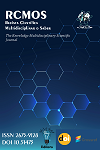The journey towards female recognition in martial arts
The journey towards female recognition in martial arts
DOI:
https://doi.org/10.51473/rcmos.v1i1.2025.1598Keywords:
martial arts; gender; MMA; femininity; sports governance; media; equity policies.Abstract
This article analyzes the path taken to consolidate women's participation in martial arts, focusing on MMA and Muay Thai, through a review of academic literature and institutional documents. The article examines the relationship between historical events, cultural dynamics, and equity policies, highlighting how the female presence in these sports challenges gender norms and transforms the competitive landscape. It argues that the recognition of women's sports depends on the correlation between three structuring axes: (i) symbolic and competitive references that generate a demonstrative effect; (ii) training networks and technical infrastructure that support permanence; and (iii) media strategies that increase visibility and reposition narratives. Therefore, practical recommendations are presented for sports governance, specialized media, and training programs for female leaders.
Downloads
References
HANNON, A.; PHIPPS, C. Pink gloves still give black eyes: Exploring ‘alternative’ femininity in women’s combat sports. Martial Arts Studies, v. 3, p. 24–37, 2017. Disponível em: https://doi.org/10.18573/mas.30 DOI: https://doi.org/10.18573/j.2017.10093
CLARINGBOULD, I. E. C.; KNOPPERS, A. E. Doing and undoing gender in sport governance. Sex Roles, v. 58, n. 1–2, p. 81–92, 2008. DOI: https://doi.org/10.1007/s11199-007-9351-9
FINK, J. S. Female athletes, women’s sport, and the sport media commercial complex: Have we really “come a long way, baby”? Sport Management Review, v. 18, n. 3, p. 331–342, 2015. Disponível em: https://doi.org/10.1016/j.smr.2014.05.001 DOI: https://doi.org/10.1016/j.smr.2014.05.001
GREEN, M. Integrating macro- and meso-level approaches: A comparative analysis of elite sport development in Australia, Canada and the United Kingdom. European Sport Management Quarterly, v. 5, n. 2, p. 143–165, 2005. Disponível em: https://doi.org/10.1080/16184740500188805 DOI: https://doi.org/10.1080/16184740500188805
HENRY, I.; ROBINSON, L. Gender equality and leadership in Olympic bodies. Lausanne: International Olympic Committee, 2010.
LEBEL, K.; DANYLCHUK, K. How Tweet it is: A gendered analysis of professional tennis players’ self-presentation on Twitter. International Journal of Sport Communication, v. 5, n. 4, p. 461–480, 2012. DOI: https://doi.org/10.1123/ijsc.5.4.461
RASMUSSEN, K.; DUFUR, M. J.; COPE, M. R.; PIERCE, H. Gender marginalization in sports participation through advertising: The case of Nike. International Journal of Environmental Research and Public Health, v. 18, n. 15, p. 759, 2021. Disponível em: https://doi.org/10.3390/ijerph18157759 DOI: https://doi.org/10.3390/ijerph18157759
SCHEADLER, T.; WAGSTAFF, A. Exposure to women’s sports: Changing attitudes toward female athletes. The Sport Journal, v. 19, n. 1, p. 1–17, 2018.
SISJORD, M. K.; KRISTIANSEN, E. Elite women wrestlers’ muscles: Physical strength and a social burden. International Review for the Sociology of Sport, v. 44, n. 2–3, p. 231–246, 2009. Disponível em: https://doi.org/10.1177/1012690209335278 DOI: https://doi.org/10.1177/1012690209335278
TRUYENS, J.; DE BOSSCHER, V.; HEYNDELS, B.; WESTERBEEK, H. A resource-based perspective on countries’ competitive advantage in elite athletics. International Journal of Sport Policy and Politics, v. 6, n. 3, p. 459–489, 2014. DOI: https://doi.org/10.1080/19406940.2013.839954
Downloads
Published
Issue
Section
Categories
License
Copyright (c) 2025 Larissa de Freitas Coutinho Oliveira (Autor)

This work is licensed under a Creative Commons Attribution 4.0 International License.












